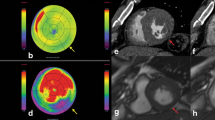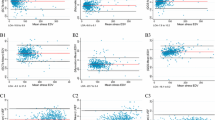Abstract
The dataset obtained with 64-slice multidetector CT (MDCT) for coronary artery evaluation can be used to calculate important left ventricular (LV) volumetric parameters. We compared LV parameters derived by new, commercially available, fully automated software for MDCT (Syngo Circulation, Siemens, Germany) to cardiac magnetic resonance (CMR) as a reference standard. Twenty patients underwent CMR after completing a clinically indicated MDCT. Ejection fraction (EF), end-systolic volume (ESV), end-diastolic volume (EDV), stroke volume (SV), and myocardial mass (MM) for MDCT were obtained using automated software and were compared to CMR measurements, with papillary muscles (PMs) included in, or excluded from, the blood pool. The Pearson correlation coefficient (r) and Bland-Altman method were used to determine agreement between methods. When PMs were included in the blood pool, the correlation was excellent for EF (r = 0.92, p < 0.001), ESV (r = 0.86, p < 0.001), and EDV (r = 0.80, p < 0.001). When PMs were excluded from CMR, correlation was still very good for EF (r = 0.89, p < 0.001), ESV (r = 0.82, p < 0.001), and EDV (r = 0.82, p < 0.001). MDCT values for SV and MM showed a good correlation compared to both CMR methods. When PMs were included, the correlation was good for SV (r = 0.70, p < 0.001), and MM (r = 0.70, p < 0.001); when they were excluded, the correlation was less robust but still significant for SV (r = 0.71, p < 0.001) and MM (r = 0.73, p < 0.001). In conclusion, EF, ESV, and EDV obtained by MDCT using simple, automated software correlated very well with CMR; SV and MM showed good correlation. Automated analysis of volumetric parameters by MDCT can be reliably utilized for clinical purposes.

Similar content being viewed by others
References
Burns RJ, Gibbons RJ, Yi Q, Roberts RS, Miller TD, Schaer GL, Anderson JL, Yusuf S (2002) The relationships of left ventricular ejection fraction, end-systolic volume index and infarct size to six-month mortality after hospital discharge following myocardial infarction treated by thrombolysis. J Am Coll Cardiol 39:30–36
Grayburn PA, Appleton CP, DeMaria AN, Greenberg B, Lowes B, Oh J, Plehn JF, Rahko P, St John SM, Eichhorn EJ (2005) Echocardiographic predictors of morbidity and mortality in patients with advanced heart failure: the Beta-blocker Evaluation of Survival Trial (BEST). J Am Coll Cardiol 45:1064–1071
Koren MJ, Devereux RB, Casale PN, Savage DD, Laragh JH (1991) Relation of left ventricular mass and geometry to morbidity and mortality in uncomplicated essential hypertension. Ann Intern Med 114:345–352
Levy D, Garrison RJ, Savage DD, Kannel WB, Castelli WP (1990) Prognostic implications of echocardiographically determined left ventricular mass in the Framingham heart study. N Engl J Med 322:1561–1566
Emond M, Mock MB, Davis KB, Fisher LD, Holmes DR Jr, Chaitman BR, Kaiser GC, Alderman E, Killip T III (1994) Long-term survival of medically treated patients in the Coronary Artery Surgery Study (CASS) Registry. Circulation 90:2645–2657
Hofmann T, Meinertz T, Kasper W, Geibel A, Zehender M, Hohnloser S, Stienen U, Treese N, Just H (1988) Mode of death in idiopathic dilated cardiomyopathy: a multivariate analysis of prognostic determinants. Am Heart J 116:1455–1463
Paul AK, Nabi HA (2004) Gated myocardial perfusion SPECT: basic principles, technical aspects, and clinical applications. J Nucl Med Technol 32:179–187
Higgins CB (1992) Which standard has the gold? J Am Coll Cardiol 19:1608–1609
Longmore DB, Klipstein RH, Underwood SR, Firmin DN, Hounsfield GN, Watanabe M, Bland C, Fox K, Poole-Wilson PA, Rees RS (1985) Dimensional accuracy of magnetic resonance in studies of the heart. Lancet 1:1360–1362
Becker A, Leber A, White CW, Becker C, Reiser MF, Knez A (2006) Multislice computed tomography for determination of coronary artery disease in a symptomatic patient population. Int J Cardiovasc Imaging
Budoff MJ, Georgiou D, Brody A, Agatston AS, Kennedy J, Wolfkiel C, Stanford W, Shields P, Lewis RJ, Janowitz WR, Rich S, Brundage BH (1996) Ultrafast computed tomography as a diagnostic modality in the detection of coronary artery disease: a multicenter study. Circulation 93:898–904
Leber AW, Knez A, von Ziegler F, Becker A, Nikolaou K, Paul S, Wintersperger B, Reiser M, Becker CR, Steinbeck G, Boekstegers P (2005) Quantification of obstructive and nonobstructive coronary lesions by 64-slice computed tomography: a comparative study with quantitative coronary angiography and intravascular ultrasound. J Am Coll Cardiol 46:147–154
Leschka S, Alkadhi H, Plass A, Desbiolles L, Grunenfelder J, Marincek B, Wildermuth S (2005) Accuracy of MSCT coronary angiography with 64-slice technology: first experience. Eur Heart J 26:1482–1487
Liew CK, Annuar R, Ong TK, Chin SP, Seyfarth TM, Sim KH (2006) Assessment of left ventricular ejection fraction: Comparison of two dimensional echocardiography, cardiac magnetic resonance imaging and 64-row multi-detector computed tomography. J Geriatr Cardiol 3:2–8
Heuschmid M, Rothfuss JK, Schroeder S, Fenchel M, Stauder N, Burgstahler C, Franow A, Kuzo RS, Kuettner A, Miller S, Claussen CD, Kopp AF (2006) Assessment of left ventricular myocardial function using 16-slice multidetector-row computed tomography: comparison with magnetic resonance imaging and echocardiography. Eur Radiol 16:551–559
Mahnken AH, Koos R, Katoh M, Spuentrup E, Busch P, Wildberger JE, Kuhl HP, Gunther RW (2005) Sixteen-slice spiral CT versus MR imaging for the assessment of left ventricular function in acute myocardial infarction. Eur Radiol 15:714–720
Raman SV, Shah M, McCarthy B, Garcia A, Ferketich AK (2006) Multi-detector row cardiac computed tomography accurately quantifies right and left ventricular size and function compared with cardiac magnetic resonance. Am Heart J 151:736–744
Schlosser T, Mohrs OK, Magedanz A, Voigtlander T, Schmermund A, Barkhausen J (2007) Assessment of left ventricular function and mass in patients undergoing computed tomography (CT) coronary angiography using 64-detector-row CT: comparison to magnetic resonance imaging. Acta Radiol 48:30–35
Author information
Authors and Affiliations
Corresponding author
Rights and permissions
About this article
Cite this article
Akram, K., Anderson, H.D. & Voros, S. Quantification of Left Ventricular Parameters Obtained by Automated Software for 64-Slice Multidetector Computed Tomography and Comparison with Magnetic Resonance Imaging. Cardiovasc Intervent Radiol 32, 1154–1160 (2009). https://doi.org/10.1007/s00270-009-9706-4
Received:
Revised:
Accepted:
Published:
Issue Date:
DOI: https://doi.org/10.1007/s00270-009-9706-4




